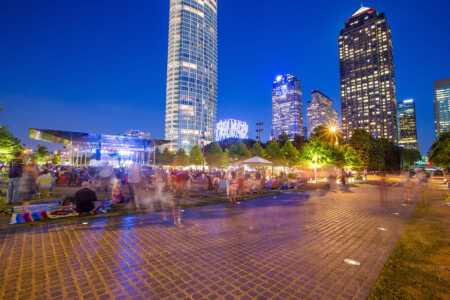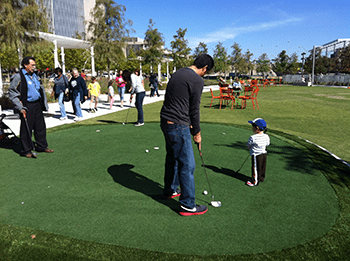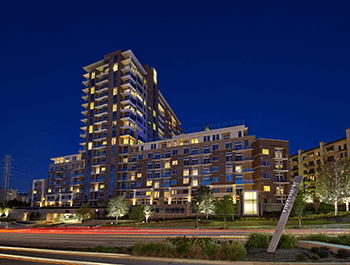On the south end of Dallas’s booming, hip high-rise district near downtown called Uptown, real estate developer Trammell Crow Company is erecting a two-building mixed-use complex called the Park District, featuring a 34-story apartment tower and a 20-story office tower. The location chosen for it: right across the street from a relatively new civic jewel, the magnetic Klyde Warren Park that spans three blocks on top of a freeway.
“Dallas does not have an oceanfront, so Klyde Warren Park is our ocean,” says Scott Krikorian, Trammell Crow’s senior managing director in Dallas. “The market wants to be by the park.”
On the northern end of Uptown’s one square mile (2.6 sq km), developer JLB Partners last year completed an 18-story, 299-unit luxury apartment building called the Brady that features a parking garage, a pet park, and a rooftop lounge, all contributing to rents that often exceed $3 per square foot ($32 per sq m). The location chosen for it: right along one of the metro area’s most popular attractions, the Katy Trail of jogging and biking paths and packed eateries on a meandering route through the center of the city.
“Dallas doesn’t have an ocean- or lakefront like a lot of other cities bigger than Dallas [have]. We jokingly say the Katy is beachfront property in Dallas,” says Bay Miltenberger, chief executive officer of JLB. “It’s like a boardwalk on Venice Beach or something.”No ocean, no mountains, no lakefront—but Dallas does have two trendy urban playgrounds, and they have been development magnets and catalysts in their own right. Klyde Warren Park, which opened in 2012, and the Katy Trail, which has been developed in stages for more than a decade, have helped propel Uptown to become the hottest real estate market in Dallas.
Residential Boom
A quarter-century ago, the name “Uptown” did not exist. The area was a mixture of scattered office buildings and empty lots, with a total property valuation of $500 million in the mid-1990s. Since then, values in the area have grown tenfold, to $5.1 billion today, with its clusters of office and residential high-rise towers, according to Uptown Dallas Inc., which oversees the district. Since 2010, the residential population has jumped by more than 50 percent to 20,000 residents today, with more than half of them being millennials.
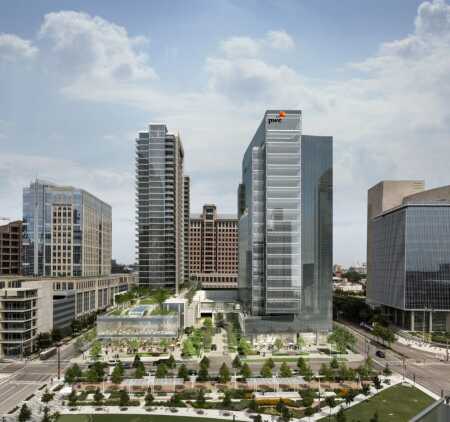
As an urban oasis between Dallas’s downtown and Uptown districts, Klyde Warren Park has turned into a magnet for real estate development, including Trammell Crow’s three-building mixed-use complex called the Park District, featuring separate office and apartment high rises. The Park District is under construction in Uptown directly across the street from the park, and the office tower attracted PricewaterhouseCoopers as the anchor tenant. (© Trammell Crow)
And the momentum keeps building. The Uptown area had more than 4,500 multifamily residential units under construction in the second quarter of 2016—about eight times more than what was under construction in all of central Dallas in the spring of 2011, according to CBRE reports. Uptown’s average multifamily monthly rent of $1.75 per square foot ($18.84 per sq m) in the second quarter of 2016 was also 40 percent higher than the market’s average and equates to rents exceeding $2,600 for a 1,500-square-foot (139 sq m) apartment.
Similarly in the office market, the Uptown area had almost 1.8 million square feet (167,000 sq m) of Class A space under construction in the second quarter this year, accounting for almost 20 percent of Dallas’s entire market, according to Jones Lang LaSalle. Uptown’s asking rents of $37 per square foot ($398 per sq m) were almost 50 percent higher than the metro market’s average.
All this momentum cannot be attributed solely to the recreational attractions, but it certainly accelerated after the trail and park opened.
“The Katy Trail and Klyde Warren Park have been absolute milestones in making Uptown as successful as it is today,” says Katy Slade, development director of national multifamily developer Gables Residential and board chair of Uptown Dallas.
John F. Crawford, chief executive officer of Downtown Dallas, the principal champion and steward of downtown, describes the importance of parks this way: “They’re not just one-off projects. They’re part of a bigger vision of connectivity, mobility, and livability. They have allowed us to develop a live/work/play environment like other cities have.”
Both the park and the trail have been honored by ULI. The park won a 2014 Urban Open Space Award for “fixing an urban fracture that isolated development,” in the words of award jury chairwoman M. Leanne Lachman. A year later, the Katy Trail won the 2015 Public Place Award from ULI North Texas.
Phil Puckett, executive vice president of CBRE in Dallas, who has been making office market deals for more than a quarter of a century, sums up the park and trail this way: “In my business career, they’re probably the two biggest things that have happened in Dallas.”
From Barrier to Bridge
The inspiration for Klyde Warren Park came from a simple observation. John Zogg, managing director of Crescent Real Estate Equities, was meeting in a downtown Dallas high rise with some out-of-town developers in 2002. Looking out the window from the 42nd floor, the group could not help but notice how Woodall Rodgers Freeway acted like a concrete crater that severed downtown from potential expansion to the north.
Zogg’s boss (then and now), Crescent chief executive officer John Goff, remarked, “Why can’t we fix that and cover it up?” Zogg remembers. To which Zogg replied, “I don’t know why we can’t.” Then Zogg began working on it.
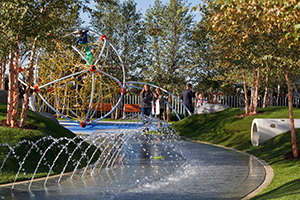
Top: The Katy Trail meanders through the heart of the city and includes two adjacent paths along most of its 3.5 miles (5.6 km), one of which is wide enough to accommodate traffic in both directions. (© Friends of the Katy Trail) Bottom: Klyde Warren Park includes a children’s park with, among other things, a child-sized amphitheater and a caterpillar fountain that turns into a “butterfly” as the water jets spray upward and outward like wings. (© The Office of James Burnett)
He formed a civic steering committee, and Crescent hired landscape architect James Burnett to create an initial design. Early milestone moments occurred in 2004 when the Real Estate Council, a community funding organization backed by leading commercial real estate companies, donated $1 million to begin feasibility studies. Texas Capital Bank founder Jody Grant heard about that gift and, unsolicited, joined the cause with a $1 million personal donation and another $1 million from his bank. Later, another milestone donation resulted in the park’s name, after energy magnate Kelcy Warren’s then-ten-year-old son.
Ironically, the Dallas business community had supported the construction of Woodall Rodgers Freeway in the 1960s, believing it would help connect downtown to the rest of the city. Four decades later, business leaders were promoting a deck over part of that freeway, believing that a new park atop the freeway could reconnect downtown to the city. “We wanted to do away with the eyesore,” Zogg says.
From the start, the project was intended to be a public/private partnership. It ended up costing $112 million, with $20 million from a 2006 voter-approved city bond issue, $20 million from the Texas Department of Transportation, and about $55 million from private fundraising. A final $16.7 million was secured during the economic recession from the federal stimulus package as a “shovel-ready” infrastructure project. The public funds went toward the deck and infrastructure, while the private funds were devoted to the park on top.
Active Programming
The champions of Klyde Warren Park set out to make its five acres (2 ha) a continually active environment, with a smorgasbord of features and programs providing lots of reasons for people to go there. Its amenities include a performance stage, a restaurant, a fountain plaza, a children’s playground, botanical gardens, a putting green, chess and checkers games, even a dog park. Klyde Warren Park hosts some 1,300 scheduled things to do every year, or more than three per day. Activities include yoga sessions on the lawn, workout classes designed for mothers and kids, children’s bilingual storytelling, food trucks at lunchtime, and an evening concert series.
“It’s one of the things that sets Klyde Warren Park apart from other parks in Dallas,” says Tara Green, president of the park’s operating organization. “When you’re first making a name for yourself in the community, you need something to draw them in.”
In this way, Klyde Warren Park is less of a traditional park and more of a town square, the centerpiece of the combined and connected center-city districts. A Dallas Morning News writer recently called the park “the best thing the city has ever done.”
The buzz about the park has been a boon to nearby real estate.
Puckett has been compiling office lease-rate trends for properties around the park. According to his data as of 2015, triple-net lease rates per square foot for Uptown towers at 2000 McKinney and 2100 McKinney had surged 56 percent and 64 percent, respectively, since the park opened. Puckett also tracked sales of two Class A office buildings that were sold before and after the park opened, and he found one increased in value by 42 percent per square foot and the other increased by 60 percent per square foot.
“I’ve never seen an impact on the office market like what’s happened from Klyde Warren Park,” Puckett says. “It’s been amazing. It changed our entire office market.”
The park has made a difference in the residential market, too. National developer Gables Residential, for instance, has two high-rise properties that opened in the late 2000s: a 35-story apartment building downtown located five blocks from the park and a 25-story apartment building in Uptown that is two blocks from the park. After the park opened, Gables determined that tenant renewals surged 25 percent and 16 percent, respectively, while rental inquiries also jumped. “I believe the park is a critical reason these properties are performing better,” says Tiffany Bakewell, Gables’s vice president of operations and strategic initiative in Dallas.
This real estate upturn, aided by national urban living trends, is extending to Dallas’s older properties in the downtown core. Buildings there that sat vacant for years are getting new lives as residential units and hotel space, such as the $175 million renovation of what was once downtown’s centerpiece, the 1950s-era Statler Hotel, into a combination hotel-apartment showpiece slated to open this fall. (See the article on the revitalization of downtown Dallas on page TK.)
Jay Parsons, who tracks Dallas’s multifamily market as a vice president of MPF Research, has determined that the current apartment construction boom in the Uptown-downtown area is dwarfing what occurred during previous development cycles, with almost three times as many units scheduled to open in 2016–2017 than during the peaks of other periods he studied going back to the 1990s.
“The magic of Klyde Warren Park was to connect Uptown and downtown and allow Uptown’s momentum to flow into downtown,” Parsons says. “What had been a nine-to-five business district is showing signs of developing into a 24/7 one.”
All this is somewhat surprising to real estate veterans, who did not expect a small park to have a larger influence on development trends than a sports arena, a museum, or other attraction might have. “Wow, we had no idea it would have this kind of impact,” says Downtown Dallas’s Crawford.
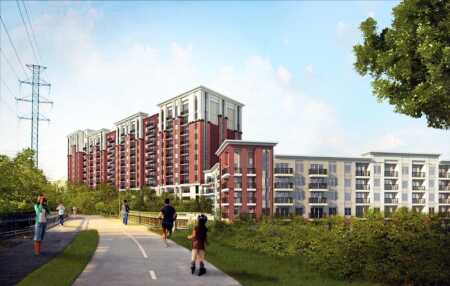
Trammell Crow Residential (TCR), which is separate from Trammell Crow Company, develops only high-rise residential projects in sites near the Katy Trail, which TCR senior managing director Steve Bancroft calls “easily the number-one residential recreation amenity in the city.” The Alexan high rise, another TCR project, is being built this year, and the project rendering above shows the trail right outside its doors. (© Trammell Crow Residential)
Other cities have taken notice. “The [freeway] deck park movement is definitely picking up speed, and the success in Dallas has been hugely influential,” says Peter Harnik, a park advocate who is the director of the Center for City Park Excellence at the nonprofit Trust for Public Land in Washington, D.C.
Deck parks are under construction or on the drawing board in nearly 20 cities, including D.C., Austin, St. Louis, and Los Angeles. Consider the L.A. suburb of Glendale, a city of roughly 200,000 residents. Park space in the central core is virtually nonexistent, and available vacant land can cost up to $10 million per acre ($24.7 million per ha), according to city officials. So Glendale has been developing a 24-acre (8 ha), multiphase “Space 134” vision for decking over State Route 134, known as the Ventura Freeway. The project is merely in the study phase, but a group of Glendale city officials visited Dallas earlier this year to see Klyde Warren Park and learn about its success.
“The biggest eye-opener for us was what it [Klyde Warren Park] did to connect two parts of the city,” says Philip Lanzafame, Glendale’s director of community development. “Indeed, a park like that can, and does, serve its purpose successfully.”
The Katy Trail winds 3.5 miles (5.6 km) between central Dallas and Uptown, following the path of the former Missouri-Kansas-Texas Railroad, which was known as the MKT or the Katy. The segment was shut down in the 1980s and donated to the city of Dallas in 1993. Soon after, the Friends of the Katy Trail formed to organize support for transforming the rail line as part of the national rails-to-trails movement, and this led to a public/private partnership, with Dallas County and state grants supplying about half of the $23 million project cost, while land donations and the Friends of the Katy Trail raised the other half.
Much of the trail opened in 2000, and it consists of one 12-foot-wide (3.7 m) concrete path for pedestrians and cyclists. Running parallel to that for most of its length is an eight-foot-wide (2.4 m) recycled-rubber path for joggers. The trail serves as a connecting spine to several city parks adjacent to or adjoining the route.
On an average day, more than 3,000 people pass by the middle of the trail, according to people counters monitored by the city’s parks department. During the past year, then, over 1 million joggers, walkers, cyclists, and the like used the Katy—more than the number of people who attended Dallas Cowboys home games last year.
Nationally, there is no longer a question of whether neighborhood trails attract residents and real estate development. American Trails, a California-based advocacy group, lists more than 70 studies on its website about the economic impacts of trails from the United States and abroad. This year, ULI published Active Transportation and Real Estate: The Next Frontier. It identifies “trail-oriented development” as the latest phase in the evolution of urban development away from car-centric models and toward more people-friendly design. ULI’s research found a positive correlation between such active transportation systems and property values.
That conclusion is certainly playing out in Dallas with increasing density levels near the Katy. Trammell Crow Residential (separate from the aforementioned Trammell Crow Company) is developing more than a dozen projects around the Dallas metro area, but will develop only high rises along the Katy Trail. At present, it has two high rises under construction: the 365-unit, 15-story Alexan catering to millennials and the baby boomer–targered 150-unit Alexan Katy Trail, the tallest section of which is ten stories.
“We do not have any interest in a residential high rise in Dallas without convenient access to the Katy Trail,” says Steve Bancroft, senior managing director of Trammell Crow Residential. “It’s easily the number-one residential recreational amenity in the city.”
Expansion Plans
Looking ahead, supporters of the Katy Trail and Klyde Warren Park are hoping to build on their projects’ popularity.
Klyde Warren boosters have begun discussions with the city about expanding the park by more than a block and adding a couple of elevated walkways that would connect the park to nearby cultural facilities, further bridging Uptown and downtown. The Katy’s Friends group is talking to the city’s parks department about enhancing the trail, with wider paths, more pedestrian bridges, and even a downtown spur that could connect with one of Klyde Warren’s conceptual elevated walkways.
But the Katy is further along with expansion plans. Already, new sections adding another four miles (6.4 km) have been under construction and are scheduled to open next spring. The $26 million expansion from the end of the trail farthest from downtown will allow the Katy to connect to other trails stretching into the Dallas suburbs.
Bordering one section of this expansion is a remodeled five-story condominium complex called the Shelby Residences in the Southern Methodist University neighborhood. Some of the Shelby’s tenants chose their condos partly because of their proximity to the Katy, so condo officials post trail construction updates on their in-house blog. Condo sales representative Julie Quigley says, “It’s certainly part of my sales pitch every single time.”
After all, the Katy Trail—and Klyde Warren Park—are as prized in Dallas as an ocean, a mountain, or a lakefront is somewhere else.
Jeffrey Spivak, a senior market analyst in suburban Kansas City, Missouri, is an award-winning writer specializing in real estate development, infrastructure, and demographic trends.

